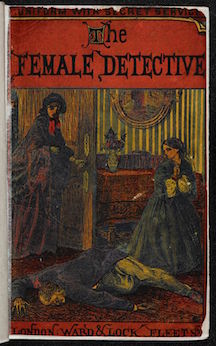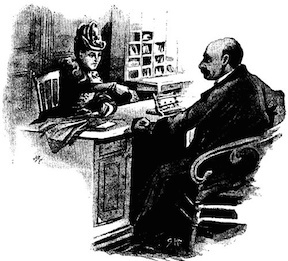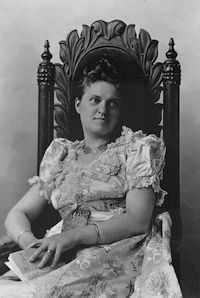Many great novels start with a premise, which mirrors or takes inspiration from something in real life. In Greer Macallister's Girl in Disguise, the inspiration is the real-life Kate Warne, the first female private detective who began her career with Pinkerton's in 1856. Learning about her made me wonder which came first – did the concept of creating a woman detective rise from some writer's fertile imagination, or was Warne the inspiration for the first fictional female sleuth?
 According to the website Crime Fiction Lover, in 1864 Andrew Forrester (aka James Redding Ware) invented Mrs. Gladden as the protagonist of his The Female Detective series of adventure stories. This appears to be the first English language fiction to feature a woman professionally solving crimes. Those stories probably sparked William Stephens Hayward to create Mrs. Paschal for his series Revelations of a Lady Detective. The Crime Fiction Lover site also notes that "Mr. Bazalgette's Agent by Leonard Merrick appeared in 1888 and can claim to be the first British novel featuring a female detective rather than a collection of serial adventures." All of these post-date Warne's real career.
According to the website Crime Fiction Lover, in 1864 Andrew Forrester (aka James Redding Ware) invented Mrs. Gladden as the protagonist of his The Female Detective series of adventure stories. This appears to be the first English language fiction to feature a woman professionally solving crimes. Those stories probably sparked William Stephens Hayward to create Mrs. Paschal for his series Revelations of a Lady Detective. The Crime Fiction Lover site also notes that "Mr. Bazalgette's Agent by Leonard Merrick appeared in 1888 and can claim to be the first British novel featuring a female detective rather than a collection of serial adventures." All of these post-date Warne's real career.
However, while researching this subject, I quickly came to realize that I needed to watch for amateur detectives as well as professional ones. That's when I found another British novelist, Catharine Crowe who, in 1841, published Adventures of Susan Hopley; or, Circumstantial Evidence. Hopley is a housekeeper and part of the story is her investigation to clear her brother from accusations of robbery and murders. As far as I can see, this is the only instance of any amateur female doing detecting work which pre-dates Warne's work life. In 1856, the same year that Warne started working at Pinkerton's, Charles Dicken's magazine Household Words published a story by Wilkie Collins that featured Anne Rodway, a "poor needlewoman" whose friend's death from a head injury spurs her to investigate the incident. It is possible that this story in a British magazine inspired Warne to apply to Pinkerton's in the USA (or vice versa) but it seems unlikely that the two events are related.
 It took some time for women writers to include professional female detectives in their works. The earliest examples are the characters Solange Fontaine in the short stories by F. Tennyson Jesse (1888), and Loveday Brooke in Catherine Louisa Pirkis' short stories, which Ludgate Magazine published in 1894.
It took some time for women writers to include professional female detectives in their works. The earliest examples are the characters Solange Fontaine in the short stories by F. Tennyson Jesse (1888), and Loveday Brooke in Catherine Louisa Pirkis' short stories, which Ludgate Magazine published in 1894.
 Most authorities believe that the first American writer to use females in a detective novel was Edward Lytton Wheeler, who published a series of dime novels starting in 1882. While there seems to be some debate about who exactly was his first female detective, he created both "Denver Doll the Detective Queen" and "dashing female detective" Lady Kate, in Fireside Companion. Another American author, Anna Katharine Green, created Amelia Butterworth for three detective novels published in 1897, 1898 and 1900. Green describes Amelia as a "nosy society spinster," who assists NY police force detective Ebenezer Gryce. It therefore seems that no American authors were inspired to create a female detective prior to Warne's employment at Pinkerton's, so perhaps she did open that door.
Most authorities believe that the first American writer to use females in a detective novel was Edward Lytton Wheeler, who published a series of dime novels starting in 1882. While there seems to be some debate about who exactly was his first female detective, he created both "Denver Doll the Detective Queen" and "dashing female detective" Lady Kate, in Fireside Companion. Another American author, Anna Katharine Green, created Amelia Butterworth for three detective novels published in 1897, 1898 and 1900. Green describes Amelia as a "nosy society spinster," who assists NY police force detective Ebenezer Gryce. It therefore seems that no American authors were inspired to create a female detective prior to Warne's employment at Pinkerton's, so perhaps she did open that door.
However, while I was doing my own detective work for this article, I came upon an excerpt from the book, Pistols and Petticoats: 175 Years of Lady Detectives in Fact and Fiction by Erika Janik (Beacon Press, 2016) at Literary Hub. What struck me the most was this highlighted quote, "The person who brought the concept of detection to the masses was not a fictional detective but a real-life one: private eye Allan Pinkerton, who had hired the first female investigator." It seems to me that if Pinkerton was that much of an inspiration for the crime fiction genre in general, it only follows that Warne must have been the first muse for 19th century writers wishing to create female detectives.
Every time BookBrowse reviews a book we go "beyond the book" to explore a related topic, such as the article above by Davida Chazan for Girl in Disguise by Greer Macallister. Most of these articles are only available to our members, but at any given time, a sampling can be found on our homepage and, from time to time, we reprint an article in this blog.
Loveday Brook, from Catherine Louisa Pirkis' short stories, courtesy of Noah's Archives.
Anna Katharine Green